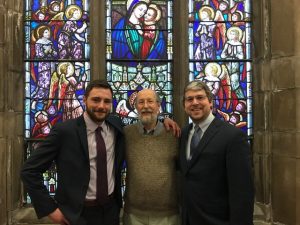Congratulations to Marquette’s Environmental Law Moot Court Team
I intended to write this post in March, upon returning from Spring Break, but 2020 got in the way. Better late than never, as they say; and I would be remiss not to recognize the excellent work of our 2019-20 Environmental Law Moot Court team, consisting of Caleb Tomaszewski and Adam Vanderheyden. The team (pictured here along with coach Dennis Grzezinski) competed in the 2020 National Environmental Law Moot Court  Competition hosted by Pace University in White Plains, New York. Caleb and Adam advanced out of the preliminary rounds to the quarterfinals, where they were narrowly defeated. The team received high praise from several judges, but Caleb reported that the most gratifying aspect was “hearing the judges say that we are ready to advocate in real life.” I appreciate the significant contributions of Dennis Grzezinski, Gabe Johnson-Karp, and Professor Alex Lemann, who coached the team with me. But most of all, bravo to Caleb and Adam on achieving the best placement in years for the Law School in the National Environmental Law Moot Court Competition.
Competition hosted by Pace University in White Plains, New York. Caleb and Adam advanced out of the preliminary rounds to the quarterfinals, where they were narrowly defeated. The team received high praise from several judges, but Caleb reported that the most gratifying aspect was “hearing the judges say that we are ready to advocate in real life.” I appreciate the significant contributions of Dennis Grzezinski, Gabe Johnson-Karp, and Professor Alex Lemann, who coached the team with me. But most of all, bravo to Caleb and Adam on achieving the best placement in years for the Law School in the National Environmental Law Moot Court Competition.
